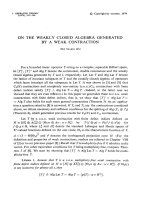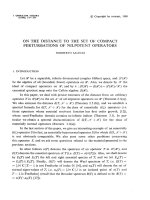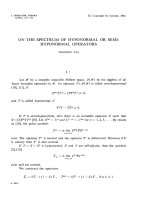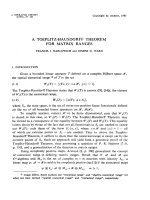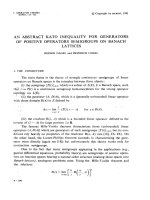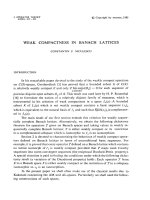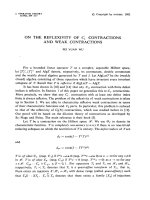Báo cáo toán học: "On the Tur´n Properties of Infinite Graphs a" pptx
Bạn đang xem bản rút gọn của tài liệu. Xem và tải ngay bản đầy đủ của tài liệu tại đây (256.09 KB, 14 trang )
On the Tur´an Properties of Infinite Graphs
Andrzej Dudek and Vojtˇech R¨odl
Department of Mathematics and Computer Science
Emory University, Atlanta, USA
{adudek,rodl}@mathcs.emory.edu
Submitted: Dec 9, 2006; Accepted: Mar 16, 2008; Published: Mar 20, 2008
Mathematics Subject Classifications: 05C35, 05C38
Abstract
Let G
(∞)
be an infinite graph with the vertex set corresponding to the set of
positive integers N. Denote by G
(l)
a subgraph of G
(∞)
which is spanned by the
vertices {1, . . . , l}. As a possible extension of Tur´an’s theorem to infinite graphs,
in this paper we will examine how large lim inf
l→∞
|E(G
(l)
)|
l
2
can be for an infinite
graph G
(∞)
, which does not contain an increasing path I
k
with k + 1 vertices.
We will show that for sufficiently large k there are I
k
–free infinite graphs with
1
4
+
1
200
< lim inf
l→∞
|E(G
(l)
)|
l
2
. This disproves a conjecture of J. Czipszer, P. Erd˝os
and A. Hajnal. On the other hand, we will show that lim inf
l→∞
|E(G
(l)
)|
l
2
≤
1
3
for
any k and such G
(∞)
.
1 Introduction
1.1 Preliminaries
Let G
(∞)
=
V (G
(∞)
), E(G
(∞)
)
be an infinite graph with the vertex set corresponding
to the set of natural numbers, i.e., V (G
(∞)
) = N, and the set of edges E(G
(∞)
). Denote
by G
(l)
the subgraph of G
(∞)
induced on the set {1, . . . , l}. Let G
(∞)
be a K
k+1
–free
graph. Then, by Tur´an’s theorem for finite graphs we get that lim inf
l→∞
|E(G
(l)
)|
l
2
≤
lim sup
l→∞
|E(G
(l)
)|
l
2
≤
1
2
1 −
1
k
. On the other hand, a K
k+1
–free graph G
(∞)
with edges
{i, j} ∈ E(G
(∞)
) if j − i = 0 mod k, achieves this bound. Hence, the Tur´an density for
finite and infinite K
k+1
–free graphs is the same.
In this paper we study the edge density of graphs without an increasing path of
length k. We say that I
k
= i
1
i
2
. . . i
k+1
is an increasing path of G
(∞)
if i
1
< i
2
< · · · < i
k+1
and {i
j
, i
j+1
} ∈ E(G
(∞)
). One can easily see that for any fixed l there exists a graph G
(l)
not containing I
k
such that |E(G
(l)
)| equals to the Tur´an number for K
k+1
–free graphs.
Hence, for finite graphs forbidding I
k
leads to the same restriction on number of edges
the electronic journal of combinatorics 15 (2008), #R47 1
as forbidding K
k+1
. While the maximum value lim sup
l→∞
|E(G
(l)
)|
l
2
can achieve over all
I
k
-free infinite graphs G is
1
2
1−
1
k
, the corresponding value for the limit inferior is harder
to find. Set
p(G) = lim inf
l→∞
|E(G
(l)
)|
l
2
.
Furthermore, let the path Tur´an number be defined as
p(k) = sup{p(G) | G is I
k
-free}.
J. Czipszer, P. Erd˝os and A. Hajnal were the first ones who examined these numbers.
In [1], they showed that p(2) =
1
8
and p(3) =
1
6
. The following was stated in [1] as a
question and in [2, 3] as a conjecture.
Conjecture 1.1 ([1, 2, 3]) For any k ≥ 2 the following holds
p(k) =
1
4
1 −
1
k
. (1)
In this paper we will show that in general this fails to be true. In fact, for sufficiently
large k the value of p(k) exceeds
1
4
.
Theorem 1.2 For any k ≥ 162 the path Tur´an number satisfies
p(k) >
1
4
+
1
200
.
We were unable to decide if (1) holds for k = 4. Here we will show that (1) fails for
k = 16.
Theorem 1.3 The path Tur´an number p(16) satisfies
p(16) >
1
4
1 −
1
16
.
Moreover, complementing Theorems 1.2 and 1.3 we will show the following upper
bound, confirming that the Tur´an number for I
k
–free infinite graphs differs significantly
from those for finite graphs.
Theorem 1.4 For any k ≥ 2 the path Tur´an number satisfies
p(k) ≤
1
3
.
1.2 Reformulation
In order to prove Theorems 1.2, 1.3 and 1.4 we will work with infinite sequences of k
symbols rather than with infinite graphs. Let C = {c
n
}
∞
n=1
be a sequence of integers with
c
n
∈ {1, 2, . . . , k}, and
S
C
(k, l) =
{(i, j) | 1 ≤ i < j ≤ l and c
i
< c
j
}
.
the electronic journal of combinatorics 15 (2008), #R47 2
Furthermore, let
s
C
(k) = lim inf
l→∞
|S
C
(k, l)|
l
2
,
and
s(k) = sup
C
s
C
(k).
The following statement shows the equivalence between path Tur´an numbers and the
numbers s(k) for a fixed k.
Lemma 1.5 Let k ≥ 2. Then, p(k) = s(k).
Proof. For a given sequence C = {c
n
}
∞
n=1
of k symbols, let G
(∞)
be the infinite graph which
corresponds to this sequence, i.e., V (G
(∞)
) = N and E(G
(∞)
) =
{i, j} | i < j and c
i
<
c
j
}. Note, G
(∞)
is an I
k
–free. Hence, |E(G
(l)
)| = S
C
(k, l), and consequently p(k) ≥ s(k).
Conversely, let G
(∞)
be an I
k
–free infinite graph. Then, G
(∞)
defines a partition of N
N =
k
j=1
N
j
(G
(∞)
),
where
N
1
(G
(∞)
) =
α ∈ N | ∀β ∈ N : {α, β} ∈ E(G
(∞)
) ⇒ α < β
,
and
N
i
(G
(∞)
) =
α ∈ N \
i−1
j=1
N
j
(G
(∞)
) | ∀β ∈ N : {α, β} ∈ E(G
(∞)
) ⇒
α < β or β ∈
i−1
j=1
N
j
(G
(∞)
)
,
for i ∈ {2, . . . , k}. Let C = {c
n
}
∞
n=1
be the sequence which corresponds to the above
partition, i.e., c
n
= i if n ∈ N
i
(G
(∞)
). Note, |E(G
(l)
)| ≤ S
C
(k, l), and consequently,
p(k) ≤ s(k).
2 Auxiliary sequences
2.1 Sequence A = {a
n
}
∞
n=1
The sequence A = {a
n
}
∞
n=1
on the symbols {1, . . . , k}, which we define below, will consists
of infinitely many blocks. For j ∈ N, the j-th block is a subsequence of k2
j
consecutive
symbols, which consists of 2
j
one’s followed by 2
j
two’s, etc. We abbreviate such block of
length k2
j
by 2
j
⊗ {1, 2, . . . , k}. Below are the first three blocks of the sequence A:
1|1|2|2|. . .|k|k
1|1|1|1|2|2|2|2|. . .|k|k|k|k
1|1|1|1|1|1|1|1|2|2|2|2|2|2|2|2|. . .|k|k|k|k|k|k|k|k
the electronic journal of combinatorics 15 (2008), #R47 3
Formally, for a given k, A = {a
n
}
∞
n=1
is a sequence of integers with a
n
∈ {1, . . . , k} defined
as follows:
(i) for any n ≤ 2k, a
n
= i if and only if 2(i − 1) < n ≤ 2i, otherwise
(ii) for any n > 2k, a
n
= i if and only if there exists an integer number m ∈ N ∪ {0}
such that
k(2 + 2
2
+ · · · + 2
m
) + (i − 1)2
m+1
< n ≤ k(2 + 2
2
+ · · · + 2
m
) + i2
m+1
.
For i ∈ {0, 1, . . . , k}, we identify the indices n
i
(m) for which value of the sequence changes
from i to i + 1, i.e., n
i
(m) = k(2 + 2
2
+ · · · + 2
m
) + i2
m+1
. Note, n
k
(m) = n
0
(m + 1) and
n
i
(m) = (2k + 2i)2
m
+ o(2
m
). (2)
Proposition 2.1 For any i ∈ {0, 1, . . . , k − 1} we have
S
A
(k, n
i
(m)) =
4
3
k(k − 1) + 4i(i − 1)
4
m
+ o(4
m
).
Proof. First, we will find a formula for s
A
(k, n
0
(m)). Note that setting S
A
(k, n
0
(0)) = 0
we obtain that for m ≥ 1,
S
A
(k, n
0
(m)) = S
A
(k, n
0
(m − 1)) +
k−1
j=1
j(2 + 2
2
+ · · · + 2
m
)2
m
= S
A
(k, n
0
(m − 1)) + k(k − 1)2
m
(2
m
− 1),
and hence by induction,
S
A
(k, n
0
(m)) = k(k − 1)
m
j=1
2
j
(2
j
− 1) =
4
3
k(k − 1)4
m
+ o(4
m
).
Similarly, for i ≥ 1,
S
A
(k, n
i
(m)) = S
A
(k, n
0
(m)) +
i−1
j=1
j(2 + 2
2
+ · · · + 2
m+1
)2
m+1
= S
A
(k, n
0
(m)) + i(i − 1)2
m+1
(2
m+1
− 1)
=
4
3
k(k − 1) + 4i(i − 1)
4
m
+ o(4
m
).
By Proposition 2.1 and equation (2) we obtain the following.
the electronic journal of combinatorics 15 (2008), #R47 4
Corollary 2.2 For any i ∈ {0, 1, . . . , k − 1} we have
lim
m→∞
S
A
(k, n
i
(m))
n
i
(m)
2
=
1
3
k(k − 1) + i(i − 1)
(k + i)
2
.
Denote the above limit by t
A
(i).
Remark 2.3 Note that the existence of the limit t
A
(i) means that the behavior of
S
A
(k,x)
x
2
,
as a function of x with domain equal to the sequence n
1
(1) < · · · < n
k
(1) < n
1
(2) < · · · <
n
k
(2) < · · · < n
i
(m) < · · · , becomes close to periodic (with period k) for m large. In
particular, t
A
(0) = t
A
(k).
2.2 Sequence B = {b
n
}
∞
n=1
Now, we define the second auxiliary sequence. For an even number k, let B = {b
n
}
∞
n=1
be
a sequence of integers with b
n
∈ {1, . . . , k} such that
b
n
=
a
n
+
k
2
mod k, if a
n
+
k
2
= 0 mod k,
k, otherwise.
Proposition 2.4 For any i ∈ {0, 1, . . . , k − 1} we have
S
B
(k, n
i
(m)) =
k
2
−
4
3
k + 2i(k + 2i − 2)
4
m
+ o(4
m
), if 0 ≤ i ≤
k
2
,
3k
2
−
10
3
k + (2i − k − 2)(2i − k)
4
m
+ o(4
m
), otherwise.
Proof. First, we will find a formula for S
B
(k, n
0
(m)). Recall that the m-th block is now
of the form 2
m
⊗ {
k
2
+ 1, . . . , k, 1, . . . ,
k
2
}. The number of pairs b
α
< b
β
, where b
α
belongs
to the first m − 1 blocks and b
β
= j + 1, for j = 1, . . . , k −1, and belongs to the last block,
is equal to
j(2 + 2
2
+ · · · + 2
m−1
)2
m
.
Setting S
B
(k, n
0
(0)) = 0 yields for m ≥ 1,
S
B
(k, n
0
(m)) = S
B
(k, n
0
(m − 1)) +
k−1
j=1
j(2 + 2
2
+ · · · + 2
m−1
)2
m
+ 2
k
2
2
(2
m
)
2
,
where the last quantity counts the pairs b
α
< b
β
of the last block. Hence,
S
B
(k, n
0
(m)) = S
B
(k, n
0
(m − 1)) + k(k − 1)2
m
(2
m−1
− 1) +
k
2
k
2
− 1
4
m
,
and by induction
S
B
(k, n
0
(m)) = k(k − 1)
m
j=1
2
j
(2
j−1
− 1) +
k
2
k
2
− 1
m
j=1
4
j
=
2
3
k(k − 1)4
m
+
2
3
k
k
2
− 1
4
m
+ o(4
m
)
=
k
2
−
4
3
k
4
m
+ o(4
m
).
the electronic journal of combinatorics 15 (2008), #R47 5
Now suppose that i ∈ {0, . . . ,
k
2
}. Then,
S
B
(k, n
i
(m)) = S
B
(k, n
0
(m)) +
i+
k
2
−1
j=
k
2
j(2 + 2
2
+ · · · + 2
m
)2
m+1
+
i
2
(2
m+1
)
2
= S
B
(k, n
0
(m)) + i(k + i − 1)2
m+1
(2
m
− 1) + 2i(i − 1)4
m
= S
B
(k, n
0
(m)) + 2i(k + 2i − 2)4
m
+ o(4
m
)
=
k
2
−
4
3
k + 2i(k + 2i − 2)
4
m
+ o(4
m
).
Similarly, for i ∈ {
k
2
+ 1, . . . , k − 1}, we get
S
B
(k, n
i
(m)) = S
B
(k, nk
2
(m)) +
i−
k
2
−1
j=1
j(2 + 2
2
+ · · · + 2
m+1
)2
m+1
= S
B
(k, nk
2
(m)) + (2i − k − 2)(2i − k)4
m
+ o(4
m
)
=
3k
2
−
10
3
k + (2i − k − 2)(2i − k)
4
m
+ o(4
m
).
By Proposition 2.4 and equation (2) we get the following.
Corollary 2.5 For any i ∈ {0, 1, . . . , k − 1} we have
t
B
(i) = lim
m→∞
S
B
(k, n
i
(m))
n
i
(m)
2
=
1
4
k
2
−
1
3
k+
i
2
(k+2i−2)
(k+i)
2
, if 0 ≤ i ≤
k
2
,
3
4
k
2
−
5
6
k+
1
4
(2i−k−2)(2i−k)
(k+i)
2
, otherwise.
The meaning of the existence of t
B
(i) is similar as in Remark 2.3.
3 Proof of Theorem 1.2
We start with an outline of the proof. First, we redefine the sequence B by adding k
to all its terms, i.e., b
n
:= b
n
+ k. For an even integer k we construct a new sequence
C = {c
n
}
∞
n=1
setting c
2l−1
= a
l
and c
2l
= b
l
, for l ∈ N. Note, C is a sequence defined on
symbols {1, 2, . . . , 2k}. It is easy to see that, if c
i
< c
j
, then c
i
, c
j
∈ A, or c
i
, c
j
∈ B, or
c
i
∈ A and c
j
∈ B. Hence,
S
C
(2k, 2l) = S
A
(k, l) + S
B
(k, l) +
{(a
i
, b
j
) | a
i
∈ {a
n
}
l
n=1
, b
j
∈ {b
n
}
l
n=1
, 1 ≤ i ≤ j ≤ l}
.
Consequently,
S
C
(2k, 2l)
(2l)
2
≥
1
4
S
A
(k, l)
l
2
+
S
B
(k, l)
l
2
+
1
8
. (3)
the electronic journal of combinatorics 15 (2008), #R47 6
0 100 200 300 400 500 600 700 800 900 1000
0.24
0.25
0.26
0.27
0.28
0.29
0.3
0.31
0.32
0.33
0.34
t
A
t
B
t
C
0.255
Figure 1: Density functions of sequences A, B and C.
Figure 1 describes the behavior of the density function for the sequences A, B and C on
one block for k = 1000 and a large value of m. More precisely, it gives the graphs of
t
A
(1000), t
B
(1000) and t
C
(2000) as a function of i = 1, . . . , 1000. Based on this, one can
anticipate that s
C
(2000) > 0.255. Indeed, we will show that for k large enough (k ≥ 162)
the sequence {c
n
} implies the statement of Theorem 1.2.
Proof of Theorem 1.2. In view of Lemma 1.5 we need to show that s
C
(2k) > 0.255. To
this end, we will verify that the limit inferior of the right side of (3) is larger than 0.255,
as l goes to infinity. For any l, there are integers m and i such that n
i
(m) ≤ l < n
i+1
(m).
Since S
A
(k, l) is increasing in l, we thus have
S
A
(k, l)
l
2
≥
S
A
(k, n
i
(m))
(n
i+1
(m))
2
, (4)
and similarly,
S
B
(k, l)
l
2
≥
S
B
(k, n
i
(m))
(n
i+1
(m))
2
. (5)
In view of Propositions 2.1 and 2.4 and equation (2), for any i ∈ {0, . . . , k − 1}, we have,
lim
m→∞
S
A
(k, n
i
(m))
(n
i+1
(m))
2
=
k(k−1)
3
+ i(i − 1)
(k + i + 1)
2
,
and
lim
m→∞
S
B
(k, n
i
(m))
(n
i+1
(m))
2
=
k
2
−
4
3
k+2i(k+2i−2)
4(k+i+1)
2
, if i ∈ {0, . . . ,
k
2
− 1},
3k
2
−
10
3
k+(2i−k−2)(2i−k)
4(k+i+1)
2
, if i ∈ {
k
2
, . . . , k − 1}.
the electronic journal of combinatorics 15 (2008), #R47 7
Consequently,
lim inf
l→∞
S
A
(k, l)
l
2
+
S
B
(k, l)
l
2
≥ min
i
lim
m→∞
S
A
(k, n
i
(m))
(n
i+1
(m))
2
+ lim
m→∞
S
B
(k, n
i
(m))
(n
i+1
(m))
2
.
Hence, it suffices to verify that for any i ∈ {0, . . . ,
k
2
− 1}
k(k−1)
3
+ i(i − 1)
(k + i + 1)
2
+
k
2
−
4
3
k + 2i(k + 2i − 2)
4(k + i + 1)
2
> 0.52, (6)
and for any i ∈ {
k
2
, . . . , k − 1}
k(k−1)
3
+ i(i − 1)
(k + i + 1)
2
+
3k
2
−
10
3
k + (2i − k − 2)(2i − k)
4(k + i + 1)
2
> 0.52, (7)
for k large enough. Multiplying both sides of (6) and (7) by (k + i + 1)
2
one can verify
that inequality (6) holds for k ≥ 162 and inequality (7) for k ≥ 35.
4 Proof of Theorem 1.3
To prove Theorem 1.3 we need to refine some of the estimates made above. Observe that
our main “tool” was the fact that for any l there are integers m ∈ N and i ∈ {0, . . . , k −1}
such that n
i
(m) ≤ l < n
i+1
(m), and consequently that (4) and (5) hold. In order to
strengthen inequalities (4) and (5) we choose an integer r, which is a power of 2, and
further subdivide the interval
n
i
(m), . . . , n
i+1
(m) − 1
into r disjoint intervals of the
same length, i.e.,
n
i
(m), . . . , n
i+1
(m) − 1
=
r−1
j=0
n
i
(m) +
j
r
2
m+1
, . . . , n
i
(m) +
j + 1
r
2
m+1
− 1
.
Let n
j
i
(m) = n
i
(m) +
j
r
2
m+1
for j ∈ {0, 1, . . . , r}. Note, n
r
i
(m) = n
0
i+1
(m) and
n
j
i
(m) =
2k + 2i + 2
j
r
2
m
+ o(2
m
). (8)
Then, the following two statements hold.
Proposition 4.1 Let r be a power of 2. Then, for any i ∈ {0, 1, . . . , k − 1} and j ∈
{0, 1, . . . , r − 1} we have
S
A
(k, n
j
i
(m)) =
4
3
k(k − 1) + 4i(i − 1) + 8i
j
r
4
m
+ o(4
m
),
for m sufficiently large.
the electronic journal of combinatorics 15 (2008), #R47 8
Proof. Note that
S
A
(k, n
j
i
(m)) = S
A
(k, n
i
(m)) + i(2 + 2
2
+ · · · + 2
m+1
)
j
r
2
m+1
= S
A
(k, n
i
(m)) + 8i
j
r
4
m
+ o(4
m
),
which in view of Proposition 2.1 yields the required statement.
Proposition 4.2 Let r be a power of 2. Then, for any i ∈ {0, 1, . . . , k − 1} and j ∈
{0, 1, . . . , r − 1} we have
S
B
(k, n
j
i
(m)) =
k
2
−
4
3
k + 2i(k + 2i − 2) +
j
r
(2k + 8i)
4
m
+ o(4
m
), if 0 ≤ i ≤
k
2
− 1,
3k
2
−
10
3
k + (2i − k − 2)(2i − k) +
j
r
(8i − 4k)
4
m
+ o(4
m
), otherwise.
for m sufficiently large.
Proof. For i ∈ {0, . . . ,
k
2
− 1} we get
S
B
(k, n
j
i
(m)) = S
B
(k, n
i
(m)) +
k
2
+ i
(2 + 2
2
+ · · · + 2
m
)
j
r
2
m+1
+ i2
m+1
j
r
2
m+1
= S
B
(k, n
i
(m)) +
j
r
(2k + 8i)4
m
+ o(4
m
).
Similarly, for i ∈ {
k
2
, . . . , k − 1}, we have
S
B
(k, n
j
i
(m)) = S
B
(k, n
i
(m)) +
i −
k
2
(2 + 2
2
+ · · · + 2
m+1
)
j
r
2
m+1
= S
B
(k, n
i
(m)) +
j
r
(8i − 4k)4
m
+ o(4
m
).
The required statement follows now from Proposition 2.4.
Based on the above propositions we will prove Theorem 1.3.
Proof of Theorem 1.3. In view of Lemma 1.5 we need to show that s
C
(16) >
1
4
1 −
1
16
.
In order to prove it, we will show that the limit inferior of the right side of (3) is strictly
greater than
1
4
1 −
1
16
, as l goes to infinity. For any l there are integers m ∈ N, i ∈
{0, . . . , k − 1} and j ∈ {0, . . . , r − 1} such that n
j
i
(m) ≤ l < n
j+1
i
(m), and consequently
S
A
(k, l)
l
2
≥
S
A
(k, n
j
i
(m))
(n
j+1
i
(m))
2
, (9)
and similarly,
S
B
(k, l)
l
2
≥
S
B
(k, n
j
i
(m))
(n
j+1
i
(m))
2
. (10)
the electronic journal of combinatorics 15 (2008), #R47 9
Let k = 8 and r = 64. Then, one can check
1
that for any i ∈ {0, . . . ,
k
2
− 1} and
j ∈ {0, . . . , r − 1}
k(k−1)
3
+ i(i − 1) + 2i
j
r
k + i +
j+1
r
2
+
k
2
−
4
3
k + 2i(k + 2i − 2) +
j
r
(2k + 8i)
4
k + i +
j+1
r
2
>
28
64
, (11)
and for any i ∈ {
k
2
, . . . , k − 1} and j ∈ {0, . . . , r − 1}
k(k−1)
3
+ i(i − 1) + 2i
j
r
k + i +
j+1
r
2
+
3k
2
−
10
3
k + (2i − k − 2)(2i − k) +
j
r
(8i − 4k)
4
k + i +
j+1
r
2
>
28
64
. (12)
Hence, by Propositions 4.1 and 4.2, equation (8) and inequalities (9) and (10) we
obtain
lim inf
l→∞
S
A
(k, l)
l
2
+
S
B
(k, l)
l
2
≥ min
i,j
lim
m→∞
S
A
(k, n
j
i
(m))
(n
j+1
i
(m))
2
+ lim
m→∞
S
B
(k, n
j
i
(m))
(n
j+1
i
(m))
2
>
28
64
,
which in view of (3) yields the statement of Theorem 1.3, i.e.,
s
C
(16) >
1
4
·
28
64
+
1
8
=
1
4
1 −
1
16
.
Remark 4.3 Analogously, one can show that Conjecture 1.1 fails for any k ≥ 24. In
order to do it, take a sequence C of 2k symbols from the proof of Theorem 1.3, for k ≥ 12
and even. Then an approach similar to the one used in Theorem 1.3 yields
s
C
(2k) >
1
4
1 −
1
2k + 3
.
5 Proof of Theorem 1.4
For a given k, let C = {c
n
}
∞
n=1
be a sequence of integers with c
n
∈ {1, . . . , k}. Let t > 1
be an integer and ε =
1
t
. Let
N =
k
i=1
N
(i)
(13)
be a partition such that c
n
= i for every n ∈ N
(i)
. We further subdivide each N
(i)
=
{n
i
1
< n
i
2
< · · · }, i = 1, . . . , k, into
N
(i)
=
t
j=1
N
(i,j)
,
1
The authors used Matlab [4] to verify (11) and (12).
the electronic journal of combinatorics 15 (2008), #R47 10
where N
(i,j)
= {n
i
j
< n
i
t+j
< n
i
2t+j
< · · · }. Now, we construct a new sequence D =
{d
n
}
∞
n=1
with values in {1, . . . ,
˜
k}, for
˜
k = kt, such that
d
n
= (i − 1)t + j,
for n ∈ N
(i,j)
. Let
S
D
(l) = {(n
1
, n
2
) | 1 ≤ n
1
< n
2
≤ l, i
1
< i
2
for n
1
∈ N
(i
1
)
, n
2
∈ N
(i
2
)
}.
Note,
S
C
(k, l) = |S
D
(l)|. (14)
For any i ∈ {1, . . . ,
˜
k}, let r
i
be a function defined on N such that
r
i
(l) =
|{n ∈ N | d
n
= i and n ≤ l}|
l
.
Consequently, for any l ∈ N, we have
r
1
(l), . . . , r
˜
k
(l)
∈ [0, ε]
˜
k
and
˜
k
i=1
r
i
(l) = 1. Since
the set [0, ε]
˜
k
is compact, the sequence
r
1
(l), . . . , r
˜
k
(l)
∞
l=1
has a limit point in [0, ε]
˜
k
,
say
r
1
, . . . , r
˜
k
. Therefore, there exists a sequence {l
j
}
∞
j=1
such that
lim
j→∞
r
1
(l
j
), . . . , r
˜
k
(l
j
)
=
r
1
, . . . , r
˜
k
.
Obviously,
r
1
, . . . , r
˜
k
∈ [0, ε]
˜
k
and
˜
k
i=1
r
i
= 1. Thus, the set R = {1, . . . ,
˜
k} can be
divided into 3 disjoint sets for some i
1
, i
2
∈ {1, . . . ,
˜
k} as follows:
R
1
= {1, . . . , i
1
},
R
2
= {i
1
+ 1, . . . , i
2
},
R
3
= {i
2
+ 1, . . . ,
˜
k},
and
i∈R
q
r
i
−
1
3
< ε,
for q = 1, 2, 3. Consequently, there exists j
0
such that for all j ≥ j
0
the similar inequality
holds, i.e.,
i∈R
q
r
i
(l
j
) −
1
3
< ε, (15)
for q = 1, 2, 3. Let S
1
D
(l) denote the set of pairs (n
1
, n
2
) ∈ S
D
(l) for which d
n
1
, d
n
2
∈ R
q
,
for some q ∈ {1, 2, 3}. Similarly, let S
2
D
(l) denote the set of pairs (n
1
, n
2
) ∈ S
D
(l) for
which d
n
1
∈ R
q
1
and d
n
2
∈ R
q
2
for some q
1
= q
2
∈ {1, 2, 3}. Hence,
|S
D
(l)| = |S
1
D
(l)| + |S
2
D
(l)|. (16)
the electronic journal of combinatorics 15 (2008), #R47 11
Furthermore, since
|S
1
D
(l
j
)| ≤
3
q=1
l
j
i∈R
q
r
i
(l
j
)
2
,
and (15) we infer that
lim sup
j→∞
|S
1
D
(l
j
)|
l
j
2
=
1
3
2
lim sup
j→∞
|S
1
D
(l
j
)|
l
j
3
2
≤
1
3
2
·
1
2
· 3 + O(ε) =
1
6
+ O(ε). (17)
On the other hand, due to the result of J. Czipszer, P. Erd˝os and A. Hajnal (see Theorem 2
in [1]), which states that Conjecture 1.1 is true for k = 3, we obtain that
lim inf
j→∞
|S
2
D
(l
j
)|
l
j
2
≤
1
4
1 −
1
3
=
1
6
. (18)
Consequently, by (14), (16), (17) and (18) we get
lim inf
l→∞
S
C
(k, l)
l
2
= lim inf
l→∞
|S
D
(l)|
l
2
≤ lim inf
j→∞
|S
D
(l
j
)|
l
j
2
≤ lim sup
j→∞
|S
1
D
(l
j
)|
l
j
2
+ lim inf
j→∞
|S
2
D
(l
j
)|
l
j
2
≤
1
3
+ O(ε).
Since this is true with ε arbitrarily small, we infer that
s
C
(k) ≤
1
3
.
This completes the proof of Theorem 1.4.
Remark 5.1 Slightly modifying the above proof, one can show that for given k and m
we have
p(k) ≤ p(m) +
1
2m
. (19)
Indeed, note that the set {1, . . . ,
˜
k} can be partitioned into m pairwise disjoint sets
{1, . . . ,
˜
k} =
m
q=1
R
q
,
which satisfy
i∈R
q
r
i
(l
j
) −
1
m
< ε,
for every q ∈ {1, . . . , m} and every j ≥ j
0
, for some fixed j
0
. Consequently, the left sides
of (17) and (18) can be bounded by
1
2m
+ O(ε) and p(m), respectively. Hence,
s
C
(k) ≤ p(m) +
1
2m
,
i.e., (19) holds.
the electronic journal of combinatorics 15 (2008), #R47 12
Note that if Conjecture 1.1 would be true, say for p(4), one could combine it with (19)
to improve Theorem 1.4. More precisely, we would have
p(k) ≤
1
4
1 −
1
16
+
1
8
=
5
16
,
for every k ≥ 2.
6 Concluding remarks
One can extend the definition of p(k) by allowing k to be also infinity, with the corre-
sponding parameter
p(∞) = sup
G
(∞)
lim inf
l→∞
|E(G
(l)
)|
l
2
,
where the supremum is taken over all graphs G
(∞)
without infinite increasing paths.
J. Czipszer, P. Erd˝os and A. Hajnal showed in [1] that
1
4
+
1
36
≤ p(∞) ≤
1
4
+
3
16
.
In this paper we showed that for k large enough the path Tur´an number satisfies
1
4
+
1
200
≤ p(k) ≤
1
4
+
1
12
.
Determining the precise values of p(k) and p(∞) does not seem to be an easy problem.
However, it is easy to see that for any fixed k
p(k) < p(∞). (20)
Indeed, let C = {c
n
}
∞
n=1
be a sequence of k symbols. Furthermore, let D = {d
n
}
∞
n=1
be a
sequence from the proof of Theorem 1.4 for some integer t. Then, D is a sequence of kt
symbols. Recalling the definition of N
(i)
(cf. (13)), for i = 1, . . . , k, set
l
i
(l) =
{α ∈ N
(i)
| α ≤ l}
,
and
E
i
(l) =
{(α, β) ∈ N
(i)
× N
(i)
| d
α
< d
β
and 1 ≤ α < β ≤ l}
.
Since N
(i)
induces a subsequence of the form 1|2| . . . |t|1|2| . . . |t|1|2| . . . |t| . . . we infer that
E
i
(l) =
1
4
1 −
1
t
l
i
(l)
2
+ o
l
i
(l)
2
and
k
i=1
l
i
(l) = l. Consequently,
k
i=1
E
i
(l) =
1
4
1 −
1
t
k
i=1
l
i
(l)
2
+ o
l
i
(l)
2
≥
1
4
1 −
1
t
k
l
k
2
+ o(l
2
),
the electronic journal of combinatorics 15 (2008), #R47 13
and
k
i=1
E
i
(l)
l
2
≥
1
4
1 −
1
t
1
k
+ o(1).
Hence,
s
D
(kt) ≥ s
C
(k) +
1
4
1 −
1
t
1
k
,
and finally by Lemma 1.5 we obtain (20), i.e.,
p(k) = s(k) < s(kt) = p(kt) ≤ p(∞).
Letting t → ∞, we have just showed that
p(k) +
1
4k
≤ p(∞).
Acknowledgements
We would like to thank Jan Zich, who verified our computations of inequalities (6), (7),
(11) and (12). We also owe special thanks to the referee for his or her very valuable
comments.
References
[1] J. Czipszer, P. Erd˝os, and A. Hajnal, Some extremal problems on infinite graphs,
Publications of the Math. Inst. of the Hungarian Academy of Sci. Ser. A 7 (1962),
441–456.
[2] P. Erd˝os, Problems and results in combinatorial analysis, Combinatorics (Proc. Symp.
Pure Math., vol. XIX) Amer. Math. Soc., Providence, R.I., 1971, pp. 77–89.
[3] P. Erd˝os, The Art of Counting, Selected Writings, The MIT Press, Cambridge, 1973.
[4] The MathWorks, Inc., Matlab, />the electronic journal of combinatorics 15 (2008), #R47 14
